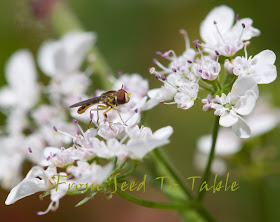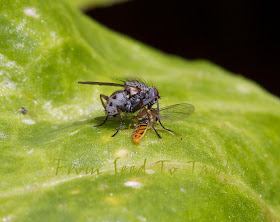It has been a banner season for bugs in my garden this spring, thank goodness it's the good ones that seem to have the upper hand. Well, to be a bit more entomologically correct, the beneficial insects rule (only some insects are true bugs). I watched as those nasty little black aphids started to colonize the fava plants, but then they started to disappear, yesterday I couldn't find any to photograph. The only treatment that I used was to cut off the tops of two aphid infested stalks and give the to the chickens. My pepper seedlings started to sport little sap draining green aphids and then they (the aphids, not the seedlings) started to disappear. For some reason the leaf miners have only done minor damage to the chard and beet greens. Cabbage worms? Not yet . . . Can I take any credit for this? Maybe a little, I've used very few pest treatments in the garden, a little neem for fungal problems and some sluggo plus when the sowbugs started to munch too much greenery. I've learned the hard way that sometimes it's best to watch and wait when the bad bugs show up, sometimes the cure is worse than the bugs. Too much spraying kills the good bugs along with the bad ones and since the pest populations rebound faster than the predator populations you can make matters worse by intervening too much. The one pest population that seems to be healthy in the garden are the cabbage aphids, they love the flower stalks of the kale that I'm allowing to bloom. But they haven't completely overtaken the plants and there are plenty of seed pods that are unaffected so I leave them be. I trim out some of the worst infected stalks sometimes and give them to the chickens (the girls love to eat almost any insect).
The other day I ventured out into the garden to photograph what interesting bugs I could find and what would sit still long enough for me to take a picture of.
Let's start with the lady beetles. The species that I've been seeing the most of lately is the Sevenspotted Lady Beetle, there's one shown above on a fava leaf. The Sevenspotted is a species that was introduced from Europe and is now found throughout most of North America. I've also seen Convergent lady beetles and Multicolored Asian lady beetles in the garden this spring. The Convergent lady beetle is a native species. I've seen a lot of lady beetle larvae and even more pupae around the garden, here's some photographs:
Sevenspotted lady beetle on Aeonium blossoms
Syrphid flies (aka Hover flies or Flower Flies) are also numerous in the garden. The Wikipedia article on Hoverflies says there are about 6,000 described species and that they are found on every continent except Antarctica. I'm not even going to try to identify exactly which species I've found in my garden (more than one). The adult flies feed on pollen and nectar, it's the larvae that munch on aphids, thrips, and other soft bodied insects. That's one reason why I let plants like alyssum and coriander bloom all around my garden, I provide food for the adults to make it easy for them to find good places to lay their eggs (aphid infested veggies). Here's some photos of adult and larvae Syrphid flies:
Syrphid flies on coriander blossoms
Syrphid fly on Alyssum blossoms
Syrphid larvae on pepper plants
I think, but I won't swear to it, that this next bristly fellow is a Tachinid fly. Adult Tachinids are pollen and nectar feeders. The UC IPM website says that the "larvae are internal parasites of immature beetles, butterflies, moths, sawflies, earwigs, grasshoppers, or true bugs".
I know that there are aphid parasitizing wasps in the garden because there are lots of aphid mummies like the one shown below. The wasps come out in force around the alyssum and coriander blossoms when the sun comes out, but they are so tiny and fast moving that it is impossible to photograph them.
The garden can be a dangerous place for the unwary.
These spiders blend in well with the white flowers.
I'm not sure what these are, perhaps another type of syrphid fly, but it was fun to watch them wallow in the poppy pollen. Bees aren't the only pollinators buzzing around the garden.
And speaking of bees, a lovely bumble bee happened by while I was busy with the camera.
I hope you enjoyed this long post about some of the small residents in my garden. I was hoping to include photos of soldier beetles and green and brown lace wings as well, they've been recent visitors, but they didn't come out for the camera.
If you would like more information about beneficial and pest insects I recommend the University of California website UC IPM Online. And another site that is loaded with photographs of insects of the US and Canada and also offers help with identifying insects is BugGuide.
Be careful what bugs you squish in the garden, some of the uglies are goodies!





















Wonderful photos, Michelle. I love photographing the little guys in my garden, too, and it's a very hard thing to do as well as you have done. Bees are the hardest – they're so busy!
ReplyDeleteAwesome photos, thanks for sharing, Gina
ReplyDeleteSqueamish ? No way ! Bugs make the best photos ! Great post, Michelle and fabulous pics. Very informative too.
ReplyDeleteOh, I LOVE bug pictures, and yours are so nicely done. Good work, you!
ReplyDeleteI love how you captured the surprising translucence of the ladybug's red armor.
That was an interesting tour of your garden - focussing in on the insect inhabitants! It is still early here for too many insects, but the bees made their appearance for awhile when the weather warmed up - left again when it got chill. Slugs are around for us year round but are ramping up in number with the milder weather conditions of spring.
ReplyDeleteFANTASTIC pictures and camera!
ReplyDeleteHoly Schmoley!
ReplyDeleteYour insect photos are really splendid! You must have a lot of patience, a great lens, and some fantastic timing to get so many glorious photos.
I've been photographing the different colors of nectar than "my" honeybees are bringing into their hive. I find this oddly fascinating.
Such nice comments from everyone, thank you, I'm glad you enjoyed the photos!
ReplyDelete---
Jamie, There are so many insects in the garden right now that all I had to do was park myself in front of some flowers and wait, the critters showed up and I snapped away (thank goodness for digital cameras).
---
Gina, you're so welcome! Thanks for stopping by and leaving a comment.
---
miss m, Another bug lover! :) I have to admit though that I'm still a bit squeamish about touching some bugs, the bigger they are the more squeamish I am.
---
Christina, Thanks so much. :) Aren't' bug photos fun, you can see so much more than with the naked eye. The lady beetle armor looks more like a haute couture coat close up, so gorgeous.
---
kitsapFG, Oh doesn't it figure, the slugs of all things are active year round, yuck. It's nice to hear that the bees are around, even if they aren't really active yet.
---
Lisa and Robb, Neato, different nectar colors, I would find that fascinating as well. Like I said to Jamie, park it in one spot and snap away, the patience comes with the weeding out on the computer. :) I'm so glad you enjoyed the photos.
---
Ribbit, thanks!
Great photos, its so difficult to take pictures of those critters even with a digital camera.
ReplyDeleteGreat photographs! So far, touch wood, my broad beans have escaped blackfly!
ReplyDeleteI love the pictures, especially the spider one. I still remember the first time I saw a young ladybug, I had no idea what is was.
ReplyDeleteWonderful pictures, Michelle! I need a camera like yours! Maybe some day...
ReplyDelete"Garden Insects of North America" by Whitney Cranshaw is another wonderful resource for bugs. I borrowed from the library several times before I ended up buying...
Thank you Michelle for this educational post accompanied with lovely pictures!
ReplyDeleteI don’t know about garden bugs a lot, I know about aphids, ladybugs and one or two more. I should definitely learn more.
I have so much aphids, but they are all on fruit trees (for now). And they cant do too much damage there. I just hope that will stay there.
Nice photos. I keep wanting t take a photo of the ladybug larvae, but still don't have one. I've seen a lot in the garden, but they area always out of focus or I don't have my camera.
ReplyDeleteAWESOME! I love the insect/bug photos, they are interesting creatures aren't they??
ReplyDeleteDang - those are truly amazing photos. This is very informative. Thanks for taking the time to share.
ReplyDeleteThose are fantastic pictures! I wish we had lots of larvae on the plants -- the aphids are harming some stuff.
ReplyDeleteThank you so much for posting a photo of an "aphid mummy"! I've been seeing some of those on my lettuce and one of the cabbages. I thought they were alive aphids, but now I know better!
ReplyDeleteWhat a cool post! We forget that there is other life in the garden...
ReplyDelete